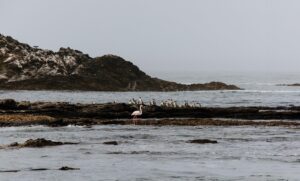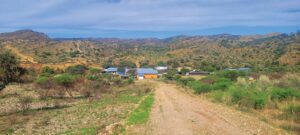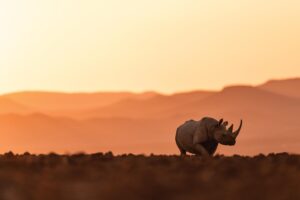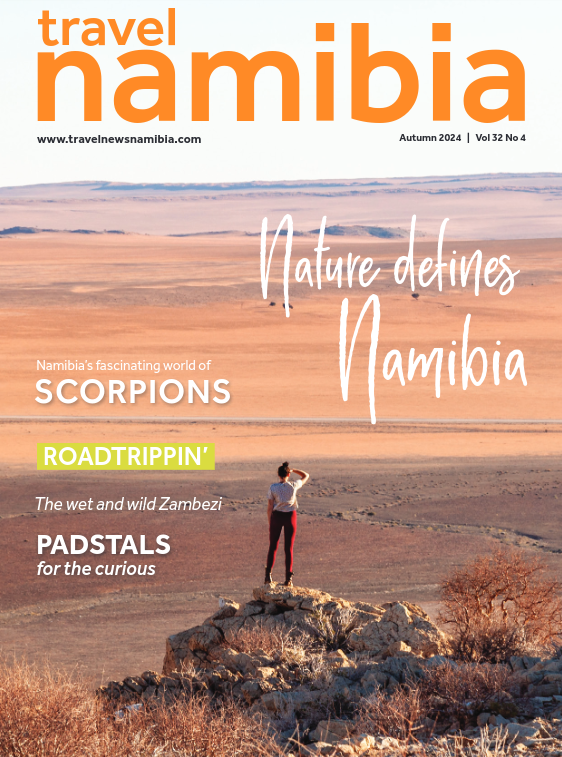
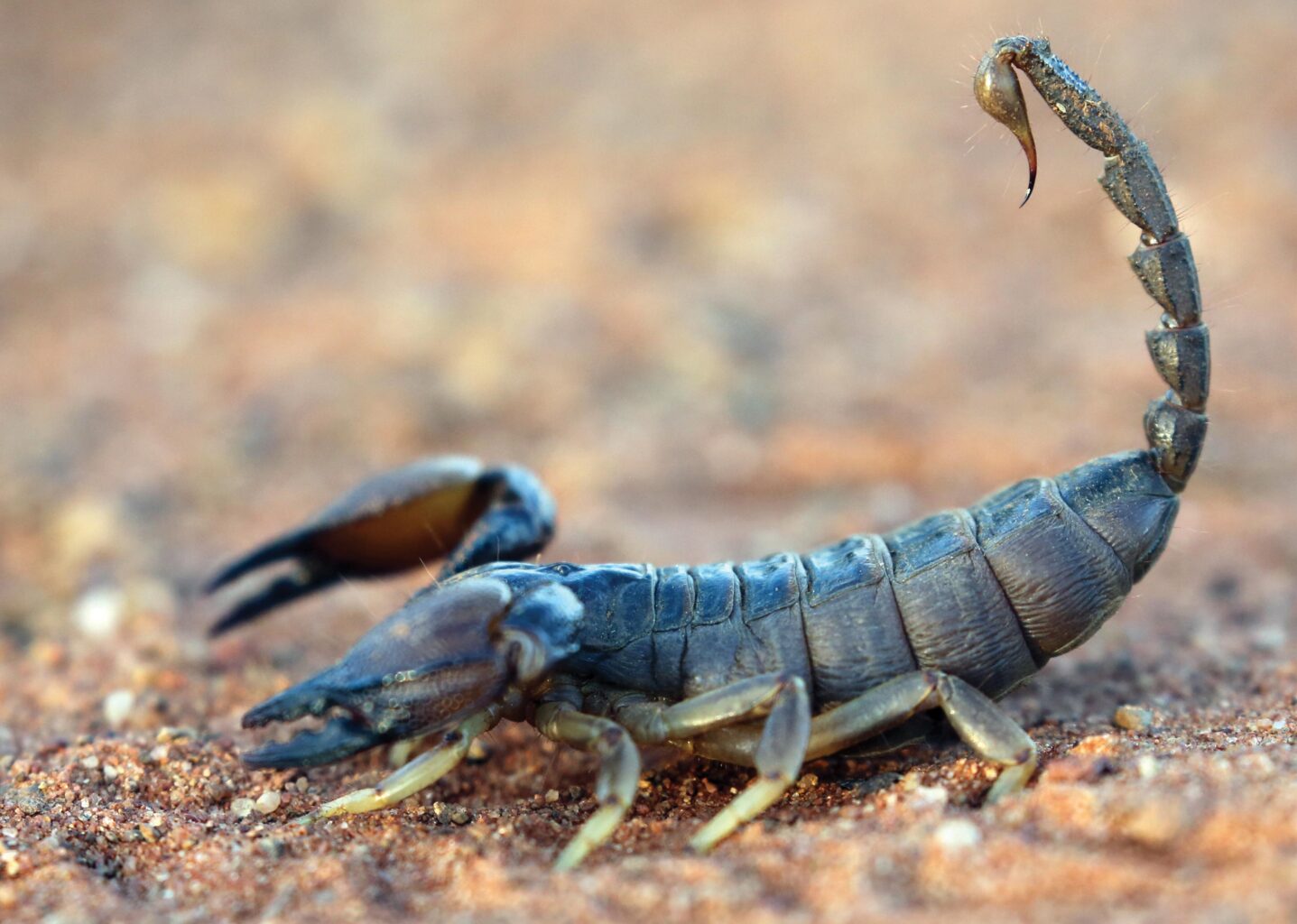
Namibia’s fascinating world of
SCORPIONS
If you are a Scorpio, you were born between October 24th and November, 22nd. If you want to see the constellation of Scorpius in the clear, possibly moonless night sky in Namibia, the best time is winter. But if you are interested in finding scorpions out there in nature, it should be a dark and warm night in summer.
Text Dirk Heinrich | Photographs Dirk Heinrich
From the Autumn 2024 issue
Officially, Namibia has 63 scorpion species, of which 14 are near-endemic and 26 are endemic. Around 140 species are found in Southern Africa. According to experts there are some more species in Namibia which have not been scientifically identified and described yet. In general there is still too little known about the distribution of species in Namibia, and hardly anything is known about their behaviour and lifecycle. Some more species wait to be discovered.
Most people are scared of scorpions because they are believed to be deadly venomous. In reality, very few (about 5%) are potentially venomous enough to cause death in humans. Therefore, only these few are of significant medical importance. Most scorpions can inflict a painful sting without further consequences. The venom of some Thicktail Scorpions of the family Buthidae and the genus Parabuthus can cause fatalities. As the most venomous scorpion in Southern Africa, including the whole of Namibia, the Rough Thicktail Scorpion (Parabuthus granulatus) tops the list. This species can be found in a variation of colour combinations. Some are black, some black with yellow legs and pincers, some brown with yellow lower legs, some orange-brown or yellow.
Fatalities have also been recorded from the normally black Hairy Thicktail Scorpion (Parabuthus villosus) which is found in western and southern Namibia. The Hairy Thicktail Scorpion, which can also be black with yellow or reddish legs and pincers, is the only scorpion in the world showing diurnal behaviour. It is the largest Thicktail Scorpion species, with a length of up to 140 millimetres, in this region. Scorpions are measured from the front margin of the carapace to the tip of the sting.
1. Opistophthalmus carinatus Radiant Burrower
Dr Ian Engelbrecht, author of the book “Field Guide to Scorpions of South Africa”, calls the Radiant Burrowing Scorpion Namibia’s national scorpion, because it is found nearly everywhere in large numbers and different sizes. Stings are painful but not serious.
2. Parabuthus villosus Hairy Thicktailed Scorpion - Dunes Swakop
The only scorpion that can be encountered wandering around in the sand dunes or the arid western landscape of Namibia is the near-endemic Hairy Thicktail Scorpion. These up to 140 mm long scorpions with small pincers and thick tails are dangerous. Victims of a sting should be taken to a hospital. The left of the two comb-like sensors, called pectines, can be seen sticking out from under the scorpion under the second leg.
3. Opistophthalmus carinatus Radiant Burrowing Scorpion - Avis Windhoek
The two median eyes in the centre on top of the carapace and the lateral eyes on each front corner of this Radiant Burrowing Scorpion can be seen very clearly. Scorpions such as the Burrowing Scorpions with big pincers and thin tails are not considered to be harmful to humans.
4. Hadogenes tityrus Namib Rock Scorpion (female)
Rock Scorpions are harmless. They have very thin tails with a very small sting. According to Dr Ian Engelbrecht’s scorpion field guide, “stings (of Namib Rock Scorpions) are unheard of and not likely to cause anything more than a mild irritation”.
5. Hadogenes tityrus Namib Rock Scorpion (male)
Male Namib Rock Scorpions have been seen wandering
around during the rainy season in December and January
looking for females. This species can be observed in a black
and a pale variety, depending on the area and habitat. They
are found in Namibia and the Northern Cape in South Africa.
6. Parabuthus granulatus Rough Thicktail Scorpion - Palmwag
A brown version of the Rough Thicktail Scorpion with yellow lower legs (tibia, basitarsus) and foot (tarsus) from the Palmwag area in former Damaraland, now the Kunene Region.
7. Parabuthus granulatus Rough Thicktail Scorpion - NaDEET
The Rough Thicktail Scorpion is considered to be the most venomous scorpion in Southern Africa. Stings must be treated as a medical emergency. This species is found all over Namibia, Botswana and the western half of South Africa. They occur in different colour variations. This one was found in the dunes in the central Namib Desert. The right yellowish-white pectine of two comb-like sensors can be seen sticking out from under the scorpion under the second leg.
8. Uroplectes otjimbinguensis
Lesser Thicktail Scorpions are small and slender. They are fast-moving and not easy to detect when they sit motionlessly. This one is Uroplectes otjimbinguensis, a Namibian near-endemic which is also found in southwestern Angola.
On the other hand, scorpions of the family Hormuridae and genus Hadogenes (Rock Scorpions) are harmless to humans and can be handled without fear. The most common one of this genus in Namibia is the Namib Rock Scorpion which is widespread in the southern and western parts of Namibia. This species is 40 to 70 mm long and has a very short tail, while the male Namaqua Rock Scorpion, which is found in the south of the country, can reach 150 mm in length. The thin tail can reach nearly twice the length of the body.
The golden rule if you encounter a scorpion is that the ones with small pincers and a thick tail are dangerous and the ones with big pincers and thin tails are not dangerous. A small scorpion is not always a young one. Measuring only 20 mm, Ansie´s Lesser Thicktail, which is not found in Namibia but in South Africa, is the smallest scorpion in southern Africa. Children and elderly people are more in danger when stung by certain species than healthy adults.
Scorpions are seen as living fossils. They have been on Earth for 420 million years. On top of their carapace they have two median eyes and a row of two to five lateral eyes on each front corner. Scorpions cannot see very well but can detect the slightest vibrations with the help of specialized hair-like structures on the body, pincers and legs. To help detect prey, predators and mates they have chemoreceptors to analyse chemical signals. Two comb- like sensors under the body, called pectines, are the most important chemoreceptors of a scorpion.
9. Uroplectes pilosus
Uroplectes pilosus is a Namibian endemic found on the gravel plains of the Namib Desert.
10. Opistophthalmus ugabensis
This Burrowing Scorpion Opistophthalmus ugabensis is a Namibian near-endemic. It is also found in southwestern Angola.
11. Uroplectes tumidimanus (male)
Another Namibian endemic which, according to Dr Lorenzo Prendini, is endemic to the Khomas Hochland, is Uroplectes tumidimanus.
12. Parabuthus brevimanus Mottled Thicktail Scorpion
The Mottled Thicktail Scorpion is another Namibian near-endemic which, with a length of 50 mm, is one of the smallest in the genus. Mottled Thicktail Scorpions are widespread throughout Namibia and in adjacent areas in the Northern Cape, South Africa. Stings are likely to be painful but serious symptoms are unlikely. This scorpion is in a typical curled up position when disturbed, waiting motionlessly for the danger or disturbance to disappear.
13. Hottentotta conspersus
Two species of nomads are found in Namibia. The Western Nomad is a Namibian near-endemic which also occurs in southwestern Angola. It is of medical importance.
14. Uroplectes planimanus Orange Lesser Thicktail
The Orange Lesser Thicktail, which is only 40 to 50 mm long, is found in most countries of southern Africa. In this unique observation a female with young on her back is engaged in a mating “dance” with a male.
15. Uroplectes planimanus Orange Lesser Thicktail
The same scene in UV light. While the adults fluoresce, the babies do not and have to wait for that until the cuticle hardens. Ultraviolet light is reflected by a hyaline layer in the exoskeleton, resulting in a turquoise greenish glow.
16. Uroplectes planimanus Orange Lesser Thicktail
These Orange Lesser Thicktail Scorpions babies are a few hours old and still white and soft. The youngsters feed on stored body fat. As the days pass, they develop body colour and patterns. The mother protects the little ones until they shed their skin for the first time and then begin to be independent and move off.
They use their pincers to catch and hold prey, to defend themselves, to climb and to burrow, and males use them to hold the partner during mating. Scorpions feed on smaller arthropods, insects, centipedes, some bigger ones on reptiles and small mammals, while their numerous enemies are birds, mongooses, baboons and reptiles. Scorpions are cannibalistic and will feed on their own and other species. They can survive without feeding for months, even years.
If a scorpion manages to catch prey which is too large to be carried with the pincers, it will carry the prey on its back to a safe retreat. Females carry their young for two weeks or longer on their back to protect them. Once they have shed their skins for the first time in their life and start looking like real scorpions they leave and become independent.
The easiest way to find scorpions at night is with the help of UV light. Scorpions fluoresce under ultraviolet light and appear in a greenish glow. One should never walk around barefoot at night or with open shoes. When camping and sleeping in the open, never leave your sleeping bag or bed roll open while sitting at the fire before going to sleep. Only get your bedding ready when you actually want to go to sleep. If you leave your shoes outside make sure there is no scorpion inside when you put them on the next morning. Always close your tent.
Scorpions are fascinating creatures and really not as bad as their reputation. TN
It was a privilege to join Dr Tharina Bird and Dr Lorenzo Prendini one night outside Windhoek to collect scorpions. Dr Bird, a South African, was the senior curator at the National Museum of Namibia from 2002 to 2009. She graduated with a PhD from Colorado State University in the US in 2015. After that she did a year of consultancy in collections in South Africa and then became a lecturer at the Botswana International University of Science and Technology (BIUST). Now she is the curator of general entomology at the Ditsong National Museum of Natural History in Pretoria, South Africa.
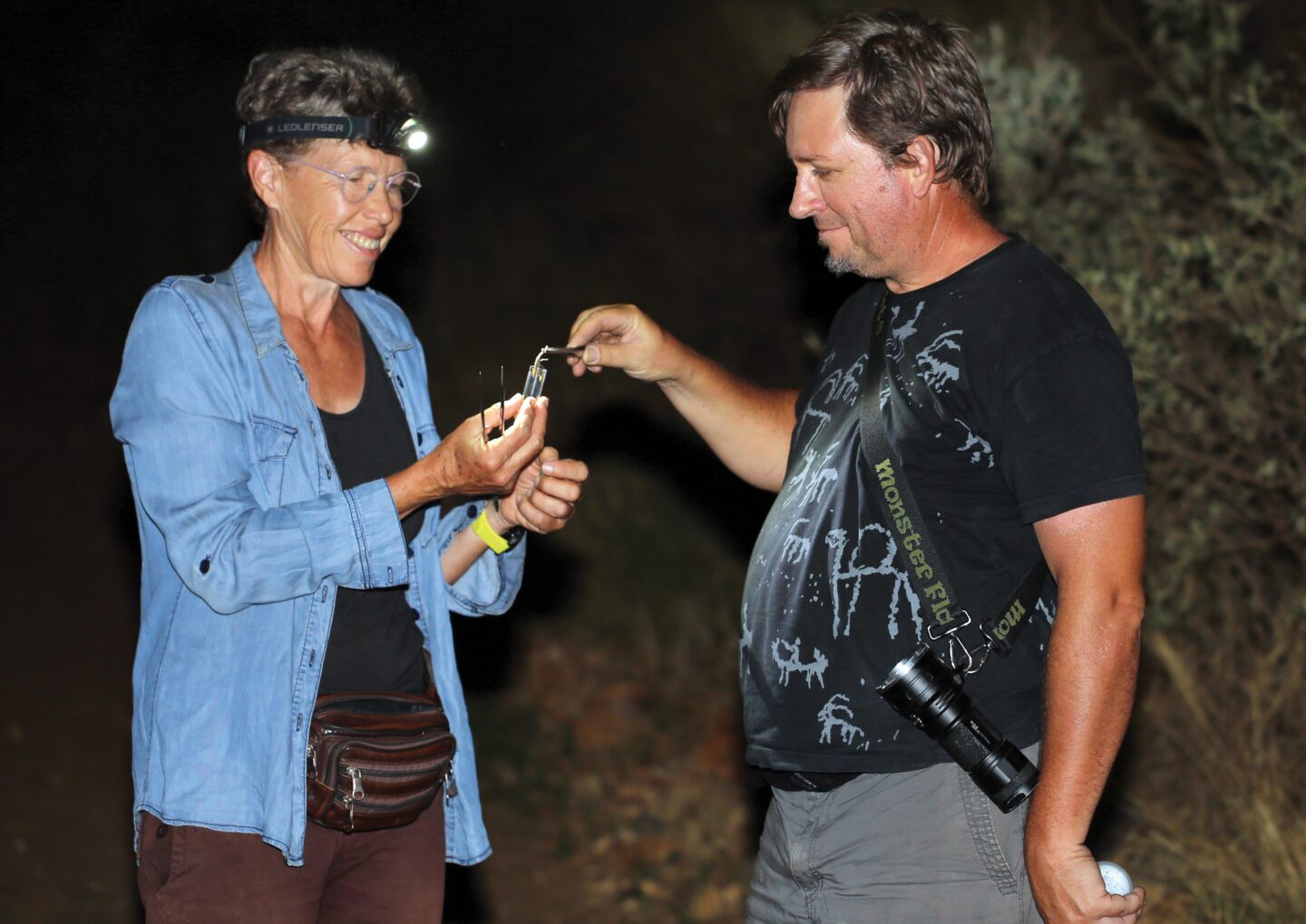
Dr Lorenzo Prendini, born in Johannesburg, South Africa, has visited Namibia many times. He is the curator for arachnida and myriapoda in the Division of Invertebrate Zoology at the American Museum of Natural History in New York and Professor at the Richard Gilder Graduate School.


